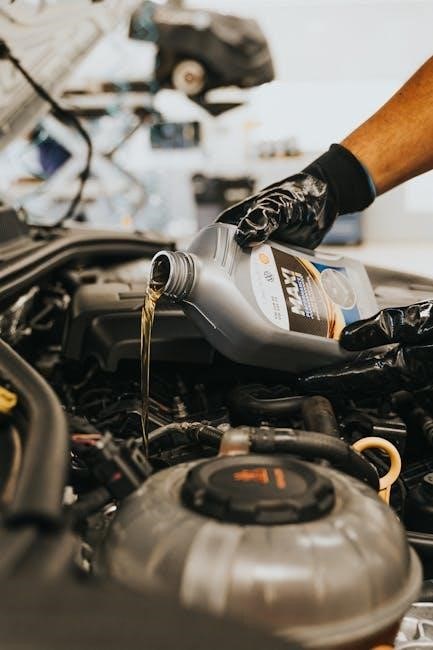Importance of Manual Transaxle Oil
Manual transaxle oil is crucial for lubricating gears, reducing friction, and preventing overheating. It cleans contaminants and protects components from wear, ensuring smooth operation and longevity of the transmission.
1.1 Role of Gear Oil in Manual Transmissions
Gear oil in manual transmissions plays a vital role by lubricating gears, synchronizers, and bearings, reducing friction and wear. It prevents overheating and cleans contaminants, ensuring smooth shifting and optimal performance. Regular use of the correct GL-4 or GL-5 rated oil maintains transmission health and longevity, protecting against damage from heat and debris. Proper lubrication ensures gears engage smoothly, reducing the risk of grinding or failure. This makes gear oil essential for maintaining the efficiency and durability of manual transmissions.
1.2 Functions of Manual Transaxle Oil
Manual transaxle oil serves multiple critical functions, including lubrication of gears, shafts, and bearings to minimize friction and wear. It cools the transmission by dissipating heat generated during operation. Additionally, it cleans the system by carrying away contaminants and debris. The oil also helps prevent corrosion and ensures smooth synchronization of gears during shifting. Regular maintenance with the correct viscosity and grade, such as GL-4 or GL-5, is essential to maintain these functions and prolong the life of the transmission.

Types of Transmission Fluid for Manual Cars
Manual cars use various transmission fluids, including SAE 75W-80, 75W-85, and GL-4 or GL-5 gear oils, each suited for different vehicles and operating conditions.
2.1 Common Types of Manual Transmission Fluids
Common types of manual transmission fluids include SAE 75W-80 and 75W-85, known for their balanced viscosity and temperature performance. GL-4 and GL-5 gear oils are also widely used, with GL-4 being preferred for manual transmissions to protect brass components. Some vehicles may require specific synthetic blends for improved lubrication and heat resistance. It’s essential to choose a fluid that matches your vehicle’s specifications to ensure optimal performance and longevity of the transmission. Always consult your vehicle’s manual for the recommended fluid type.
2.2 Viscosity Grades and Their Applications
Viscosity grades like 75W-80 and 75W-85 are common in manual transmissions, offering balanced lubrication across temperature ranges. Thinner oils (e.g., 75W-80) are ideal for colder climates, improving shifting ease. Thicker oils (e.g., 75W-90) are better for high-temperature or heavy-duty use, providing enhanced protection. The choice depends on the vehicle’s operating conditions and manufacturer recommendations. Using the correct viscosity ensures optimal gear lubrication, smooth shifting, and prevents overheating, which can damage transmission components. Always refer to your vehicle’s manual for the specified viscosity grade.
2.3 GL-4 vs GL-5: Key Differences and Recommendations
GL-4 and GL-5 are two common gear oil specifications. GL-4 is designed for manual transmissions, offering excellent protection for brass and bronze components. GL-5, while suitable for axles and differentials, contains higher sulfur levels and LSD additives that can degrade gear oil more quickly. For manual transaxles, GL-4 is recommended unless specified otherwise. Avoid using GL-5 in manual gearboxes except in emergencies, as it may reduce oil longevity. Always follow the manufacturer’s guidelines to ensure optimal performance and prevent damage to transmission components.

Maintenance Tips for Manual Transaxle Oil
Regular checks and oil changes, following manufacturer guidelines, are crucial for maintaining manual transaxle health. Use GL-4 oil unless specified otherwise to ensure optimal performance and longevity.
3.1 How to Check Manual Transmission Fluid Levels
To check manual transmission fluid levels, start by gathering tools like a socket wrench and ensuring the car is on level ground; Locate the filler plug, usually at the top or side of the transmission; Remove the plug to allow fluid to drain slightly. Inspect the fluid color and consistency; clean, amber fluid indicates good condition, while dark or gritty fluid suggests a change is needed. Reinstall the plug securely after checking to maintain proper transmission function and prevent leaks.
3.2 Importance of Regular Oil Changes
Regular oil changes are essential for maintaining manual transmission health. Fresh fluid ensures gears remain lubricated, reducing friction and wear. Over time, oil degrades, losing its ability to cool and protect components. Contaminants accumulate, risking damage. Replacing old oil with the correct GL-4 or GL-5 grade prevents corrosion and extends transmission life. Neglecting oil changes can lead to costly repairs, such as gear replacement or complete transmission rebuilds. Adhering to manufacturer-recommended intervals ensures optimal performance and longevity of the manual transaxle.
3.3 Recommended Oil Change Intervals
Most manufacturers recommend changing manual transmission fluid every 30,000 to 60,000 miles. However, vehicles used for heavy-duty operations, such as towing or frequent stop-and-go driving, may require more frequent changes, typically every 15,000 miles. Always consult the owner’s manual for specific guidance tailored to your vehicle. Regular intervals ensure optimal lubrication, prevent degradation, and maintain transmission health. Neglecting these schedules can lead to premature wear and costly repairs. Adhering to recommended intervals is crucial for extending the lifespan of your manual transaxle.

Signs Your Manual Transaxle Oil Needs Changing
Difficulty shifting gears, grinding noises, or a burnt smell indicate degraded transmission oil. Regular checks help prevent severe damage and costly repairs.
4.1 Symptoms of Degraded Transmission Oil
Symptoms include difficulty shifting gears, grinding noises, and a burnt smell. As oil degrades, it loses lubricating properties, leading to increased friction and potential component failure.
4.2 Effects of Old or Contaminated Oil
Old or contaminated oil loses its lubricating properties, leading to increased wear on gears and bearings; This can cause grinding noises, difficulty shifting, and overheating. Over time, degraded oil fails to clean effectively, allowing debris to accumulate and damage components. Prolonged use of contaminated oil can result in premature transmission failure, requiring costly repairs; Regular oil changes are essential to maintain optimal transmission performance and prevent irreversible damage.

DIY vs Professional Transmission Service
DIY transmission service can be cost-effective for knowledgeable owners, while professional service ensures expert handling of complex tasks, offering peace of mind and warranty protection.
5.1 Pros and Cons of DIY Transmission Fluid Changes
DIY transmission fluid changes can save money and empower car owners. However, they require proper tools and knowledge to avoid errors. Incorrect fluid selection or improper drainage can damage the transmission. While cost-effective for skilled individuals, DIY may lead to contamination or incomplete fluid replacement. Professionals ensure precision and use specialized equipment, reducing risks. DIY is suitable for routine maintenance but not for complex repairs. Always consult the owner’s manual for specifications to avoid costly mistakes.
5.2 When to Seek Professional Help
Seek professional help if you notice symptoms like grinding gears, slipping, or unusual noises. These indicate potential damage requiring expert diagnosis. If unsure about fluid type or replacement procedures, professionals ensure correct specifications. Complex repairs, such as bearing replacement, demand specialized tools and expertise. Contaminated fluid or high-mileage transmissions also benefit from professional service. DIY mistakes can lead to costly repairs, making professional assistance a safer choice for maintaining transmission health and performance.

Cost Implications of Transmission Oil Changes
Transmission oil change costs vary based on fluid type, labor, and location. Synthetic oils are pricier but offer better performance and longevity for manual transmissions.
6.1 Average Cost of Manual Transmission Service
The average cost for a manual transmission service ranges from $25 to $90, depending on the type of fluid used. Synthetic fluids are more expensive but offer superior performance and longevity. Labor costs typically range from 0.8 to 1.5 hours, depending on the mechanic or service center. Prices may vary based on location, vehicle brand, and the extent of the service. Overall, regular maintenance ensures optimal transmission health, making it a cost-effective investment in the long run.
6.2 Factors Affecting the Cost of Transmission Oil

The cost of transmission oil varies based on the type and brand of fluid, with synthetic options being more expensive. Vehicle make and model also influence pricing, as some require specialized fluids. Additionally, the volume of oil needed and the location where it’s purchased can impact the total cost. Dealerships often charge more than retail stores, and taxes may apply. Overall, balancing quality and budget is key to selecting the right transmission oil for your vehicle.

Best Practices for Manual Transaxle Oil
Always select the correct gear oil for your vehicle, check fluid levels regularly, and change oil as recommended to maintain optimal transmission performance and longevity.
7.1 Choosing the Right Gear Oil for Your Vehicle
Selecting the correct gear oil for your manual transaxle is essential for optimal performance. Always refer to your vehicle’s owner’s manual for specific recommendations. The right oil ensures proper lubrication, reduces friction, and prevents overheating. Viscosity and API classification (e.g., GL-4 or GL-5) must match your transmission’s needs. Using the wrong oil can lead to increased wear, poor shifting, or even damage. Synthetic oils are often recommended for better thermal stability and protection. Avoid mixing different types of oil to maintain consistency and performance.
7.2 Avoiding Common Mistakes in Oil Selection
When selecting manual transaxle oil, avoid common mistakes like using the wrong viscosity or API classification. Always consult your vehicle’s owner’s manual for specific recommendations. Using GL-5 instead of GL-4 can harm brass components in older transmissions. Avoid mixing different oil types, as this can degrade performance. Never use regular motor oil, as it lacks the necessary additives for manual transmissions. Ensuring compatibility with your vehicle’s make and model is crucial to prevent damage and maintain optimal performance.

Future Trends in Manual Transaxle Oil Technology
Advancements in synthetic gear oils are expected to enhance performance and efficiency. Eco-friendly formulations may reduce environmental impact, aligning with sustainability trends in automotive technology.
8.1 Advances in Synthetic Gear Oils
Recent advancements in synthetic gear oils have led to improved thermal stability and wear resistance. These oils offer better lubrication at extreme temperatures, reducing friction and enhancing gear life. They also have superior viscosity indexes, maintaining optimal flow in both hot and cold conditions. Additionally, synthetic oils are more resistant to degradation, extending oil change intervals. Innovations in additive technology further improve their performance, making them a preferred choice for modern manual transmissions. These advancements contribute to smoother shifting and increased transmission durability.
8.2 Environmental Impact of Transmission Fluids
Transmission fluids can have environmental implications due to their chemical composition. Traditional gear oils may contain additives that are harmful if leaked or disposed of improperly. Synthetic oils, however, are increasingly biodegradable and less toxic, reducing environmental harm. Proper disposal of used fluids is critical to prevent soil and water contamination. Manufacturers are also developing eco-friendly formulations to minimize ecological impact, aligning with stricter regulations. As awareness grows, the shift toward sustainable transmission fluids is becoming a priority in the automotive industry.



